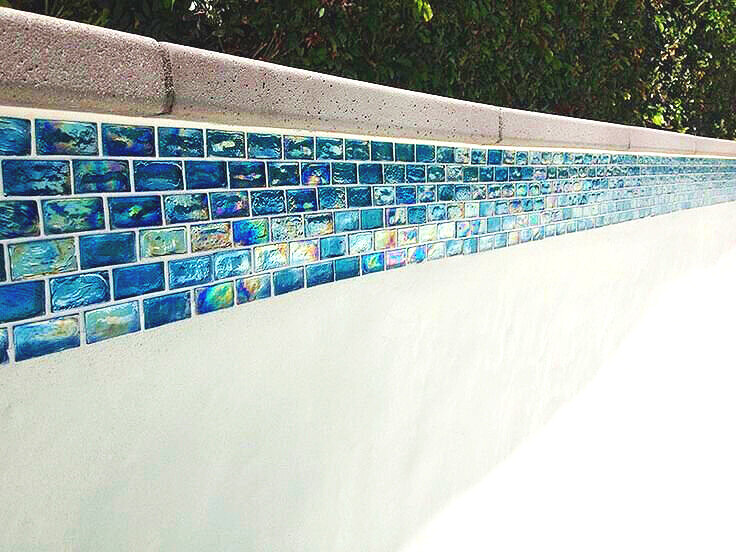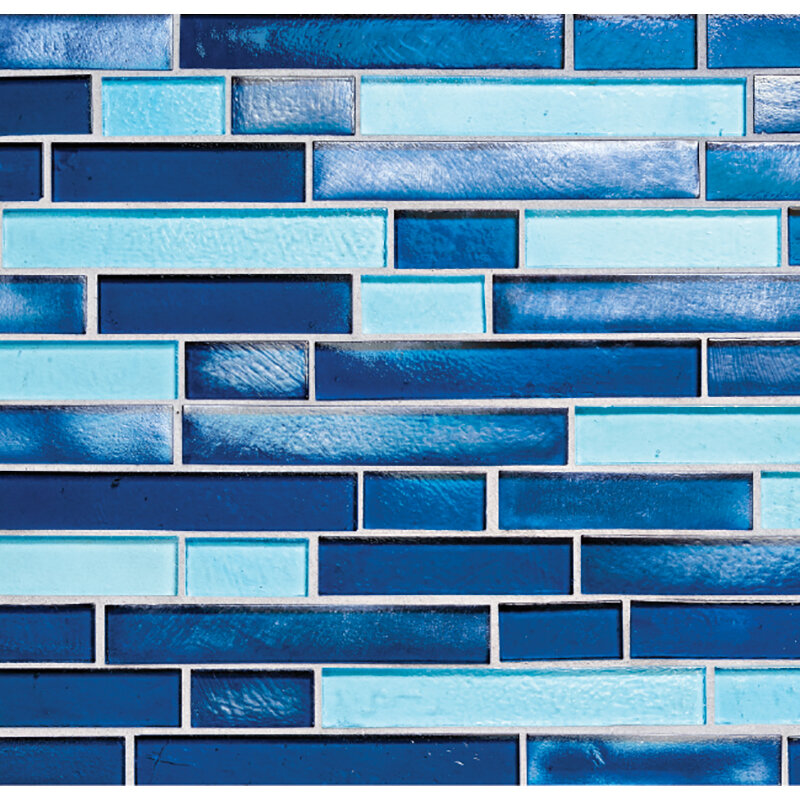Pool Tile
Classic Pool Plastering provides long-lasting solutions for various types of tile needs. Whether it be for your personal pool at home, educational institution, commercial necessities, or municipal renovations; we have never come across a pool we couldn’t tile.
Customize the look and feel of your pool with one of hundreds of the frost-proof tiles we have for you to choose between. From natural stone to stunning glass we provide the most modern trends in swimming pool tile to create a pool unique to you.
We offer complete pool and spa re-tiling, deck tiling, waterline tile replacement, tiled water features, custom logos and/or mosaics, racing lanes and targets, in addition to safety upgrades such as tile break lines, step demarcation, and frost-proof depth marker tiles.
Pool Tiling Options
Waterline Tile
This is the row of tile directly above the pool finish and just below the deck. Typically, waterline tile is 6”x6”. The water level of the pool is usually halfway up the tile. The reason tile is necessary in a pool and spa is because plaster or other pool finishes are not meant to be exposed to the sun and elements.
Spa Walls and Spillways
Another focal point of your pool is the face of the spa walls. When water flows from the spa to the pool, it pulls attention to the spillway and spa wall. Pay careful attention to the grout and tile colors you select, so that they don’t clash. Spillways are another opportunity to get creative – from widening an existing spillway, to creating two spillways, to covering the top the spillway with coping.
Raised Bond Seam
The raised bond beam is the part of the pool wall that is elevated above the lower level of the decking. This is where homeowners tend to get creative, since it the most visible tile in the pool. Consider installing smaller 1”x”1, 2”x”2, or 3”x 3″ tiles on the raised area for decorative appeal. This is also a common area to install accent tiles.
Trim Tile and Spotters
The trim is a small line of non-slip tile at the outside edge of steps and seats that help swimmers see their depths. This option also adds a decorative detail to the pool and spa. Spotters are a diamond set tile that are typically set about 12” apart.
Pool Tile Material Selection
When the time comes to choose the tile for your swimming pool, it can get a bit crazy. With tons of different pool tile options ranging from porcelain to glass. All different types of pool tile look great. But, which tile option is the best one for you and your pool? This will come down to your personal preference and the overall design of your outdoor oasis.
Negative-edge pools, spa spillways, tanning ledges and complex water features, are parts of pool designs that serve as inspiration for a stunning tile. The most commonly used types of tile in swimming pools include glass, natural stone and porcelain.
Glass Tile
In recent years, the popularity of glass tile on swimming pools has continued to rise. Glass tile is the most expensive tile option, and that’s for a good reason; since it is made from recycled glass materials, it’s the most durable and non-porous of all pool tiles. Glass tiles go great with the transparent nature of water.
Glass tiles come in a small – mosaic tile format. It has the advantage of being able to cover curved surfaces completely. Pool designers can also mix different colors of glass tile, creating a customized color scheme and thus, form an artwork. Quality of glass tile ranges from low to high, and like most things in life you get what you pay for. With lower quality glass tile, you still get reflections that can be brilliant underwater. Some other glass tiles have an iridescent coating that shimmers with the change of light and water flowing over the surface.
On the other hand, the artistic look and feel of a finished installation are more significant and dynamic with an upscale glass tile. It has a better optical quality, and its shine, color, and depth are more exciting than the look of small mosaic designs. In all-tiled pools and spas, the overall effect of glass is mesmerizing, and as waterline borders and step-markers, the internal reflections offer a gem-like luster.
Stone Tile
If you are looking to have a Classical or Mediterranean style oasis, a stone tile will give you just that; a natural look and textured feel that goes perfectly on a patio or deck. When combined with coping, the appearance is more unison. Stone tile design elements include flagstone, travertine, slate, sandstone, bluestone, and semi-polished granite tile that displays a pepper tone look.
Porcelain Tile
Porcelain tiles have been staples of pool finishing for decades. Contrary to glass tiles, these are hand-painted with exciting designs, or they are also available in a mosaic mode. Nowadays, you can find porcelain tile in a textured version that goes well with the surrounding landscape. Also, there is a textured-glazed porcelain tile that is bolder and more exciting, giving a punch to any swimming pool border.
It’s interesting how some designers prefer to mix glass, stone and porcelain tiles. With the right balance of color, texture, scale, and detail, tile can create a beautiful and continuous design.
Special Considerations
Size Matters.
Always keep in mind the size and ratios of any tile that you select for your swimming pool. It is a common knowledge that large glass tiles may crack due to thermal shock. This happens quite often when larger tiles are used along the pool’s waterline. A large format glass tile is also a big no-no for swimming pools. Large tile formats are less stable at the center and are prone to crack, especially during a low-standard installation. We highly recommend that you do your homework and ask your designer which pool tile option is the best for your swimming pool.
Freezing Conditions
There are two types of tile material suitable for water immersion in freezing climates - glass and porcelain tile. Under no circumstance should any other tile material (ceramic, slate, marble, metallic, or other) be used on swimming pools, below or at the waterline. The reason for this is the porous properties of all other types of tile. Glass is extremely dense and will absorb no water at all. Porcelain is less dense and will absorb some water, but very little-an acceptable amount for pool tiling. Ceramic is more porous and less dense; stone such as slate and marble are much less dense and layered, as well as porous, which will result in guaranteed early failure, usually within 1-3 years from installation. However, not to worry, there are many slate-look porcelain tiles available for waterline that will last decades.
Tile Installation
Our Process:
1. Chip away and remove old tile; ensure that the surface is clean and free of all debris.
2. Create an even surface by grinding down the area under the old tile, or building up areas that are not even with a mortar bed. This preparatory step ensures that there are no high or low spots that the tile will be laid against. We want the tile to be flush with the plaster.
3. Cut tiles for detail work around curves and on spillways. This is where the true skill and craftsmanship is very apparent.
4. Spread out thin set bonding agent (adhesive) where the tile will be placed on waterline. The thin set must be a swimming pool specific product. This is the “glue” that holds the tile to the edge of the pool.
5. Lay porcelain pool tile on the thin set. It is important that the tile is a pool specific, porcelain tile. The tiles are individually pressed into the thin set by hand or rubber mallet. It is important to let the tile set until firm.
6. Once the tile is firmly in place, we now spread our grout using a rubber floating tool. We will then sponge clean all excess grout.
Surface Preparation & Bonding
The other main factors in the lifespan of waterline tile are adequate preparation and cleaning prior to installation, and the quality of tile adhesive and grouts that are used. All of our tile is installed using polymer-modified, thin-set mortars that have a lifetime warranty, suitable for water immersion, and freeze resistant which are critical to ensure that tiles last decades. The tile is grouted with hydraulic, colourfast grout.











